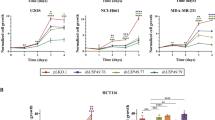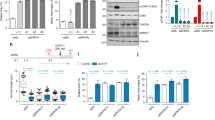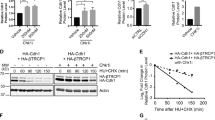Abstract
The DNA damage checkpoint is essential for the maintenance of genome integrity after genotoxic stress, and also for cell survival in eukaryotes. Claspin has a key role in the ATR (ATM and Rad3-related)-Chk1 branch of the DNA damage checkpoint and is also required for correct DNA replication. To achieve properly these functions, Claspin is tightly regulated by ubiquitinin-dependent proteasomal degradation, which controls Claspin levels in a DNA-damage- and cell-cycle-dependent manner. Here, we identified a new regulator of Claspin, the ubiquitin-specific peptidase 29, USP29. Downregulation of USP29 destabilizes Claspin, whereas its overexpression promotes an increase in Claspin levels. USP29 interacts with Claspin and is able to deubiquitinate it both in vivo and in vitro. Most importantly, USP29 knockdown results in an impaired phosphorylation of Chk1 after DNA damage and USP29-depleted cells show a major defect in the S-phase progression. With these results, we identified USP29 as a new player in the ATR-Chk1 pathway and the control of DNA replication.
This is a preview of subscription content, access via your institution
Access options
Subscribe to this journal
Receive 50 print issues and online access
$259.00 per year
only $5.18 per issue
Buy this article
- Purchase on Springer Link
- Instant access to full article PDF
Prices may be subject to local taxes which are calculated during checkout




Similar content being viewed by others
References
Cimprich KA, Cortez D . ATR: an essential regulator of genome integrity. Nat Rev Mol Cell Biol 2008; 9: 616–627.
Shiloh Y . The ATM-mediated DNA-damage response: taking shape. Trends Biochem Sci 2006; 31: 402–410.
Smits VAJ, Warmerdam DO, Freire R . 4. Mechanisms of ATR-mediated checkpoint signalling. Front Biosci 2010; 15: 840–853.
Mailand N, Falck J, Lukas C, Syljuâsen RG, Welcker M, Bartek J et al. Rapid destruction of human Cdc25A in response to DNA damage. Science 2000; 288: 1425–1429.
Peng CY, Graves PR, Thoma RS, Wu Z, Shaw AS, Piwnica-Worms H . Mitotic and G2 checkpoint control: regulation of 14-3-3 protein binding by phosphorylation of Cdc25C on serine-216. Science 1997; 277: 1501–1505.
Sanchez Y, Wong C, Thoma RS, Richman R, Wu Z, Piwnica-Worms H et al. Conservation of the Chk1 checkpoint pathway in mammals: linkage of DNA damage to Cdk regulation through Cdc25. Science 1997; 277: 1497–1501.
Lee J, Gold DA, Shevchenko A, Shevchenko A, Dunphy WG . Roles of replication fork-interacting and Chk1-activating domains from Claspin in a DNA replication checkpoint response. Mol Biol Cell 2005; 16: 5269–5282.
Petermann E, Helleday T, Caldecott KW . Claspin promotes normal replication fork rates in human cells. Mol Biol Cell 2008; 19: 2373–2378.
Uno S, Masai H . Efficient expression and purification of human replication fork-stabilizing factor, Claspin, from mammalian cells: DNA-binding activity and novel protein interactions. Genes Cells 2011; 16: 842–856.
Mailand N, Bekker-Jensen S, Bartek J, Lukas J . Destruction of Claspin by SCFbetaTrCP restrains Chk1 activation and facilitates recovery from genotoxic stress. Mol Cell 2006; 23: 307–318.
Peschiaroli A, Dorrello NV, Guardavaccaro D, Venere M, Halazonetis T, Sherman NE et al. SCFbetaTrCP-mediated degradation of Claspin regulates recovery from the DNA replication checkpoint response. Mol Cell 2006; 23: 319–329.
Mamely I, van Vugt MA, Smits VAJ, Semple JI, Lemmens B, Perrakis A et al. Polo-like kinase-1 controls proteasome-dependent degradation of Claspin during checkpoint recovery. Curr Biol 2006; 16: 1950–1955.
Kumagai A, Dunphy WG . Repeated phosphopeptide motifs in Claspin mediate the regulated binding of Chk1. Nat Cell Biol 2003; 5: 161–165.
Clarke CAL, Clarke PR . DNA-dependent phosphorylation of Chk1 and Claspin in a human cell-free system. Biochem J 2005; 388: 705–712.
Chini CCS, Chen J . Repeated phosphopeptide motifs in human Claspin are phosphorylated by Chk1 and mediate Claspin function. J Biol Chem 2006; 281: 33276–33282.
Kim JM, Kakusho N, Yamada M, Kanoh Y, Takemoto N, Masai H . Cdc7 kinase mediates Claspin phosphorylation in DNA replication checkpoint. Oncogene 2008; 27: 3475–3482.
Meng Z, Capalbo L, Glover DM, Dunphy WG . Role for casein kinase 1 in the phosphorylation of Claspin on critical residues necessary for the activation of Chk1. Mol Biol Cell 2011; 22: 2834–2847.
Verlinden L, Vanden Bempt I, Eelen G, Drijkoningen M, Verlinden I, Marchal K et al. The E2F-regulated gene Chk1 is highly expressed in triple-negative estrogen receptor /progesterone receptor /HER-2 breast carcinomas. Cancer Research 2007; 67: 6574–6581.
Freire R, van Vugt MATM, Mamely I, Medema RH . Claspin: timing the cell cycle arrest when the genome is damaged. Cell Cycle 2006; 5: 2831–2834.
Bassermann F, Frescas D, Guardavaccaro D, Busino L, Peschiaroli A, Pagano M . The Cdc14B-Cdh1-Plk1 axis controls the G2 DNA-damage-response checkpoint. Cell 2008; 134: 256–267.
Gao D, Inuzuka H, Korenjak M, Tseng A, Wu T, Wan L et al. Cdh1 regulates cell cycle through modulating the claspin/Chk1 and the Rb/E2F1 pathways. Mol Biol Cell 2009; 20: 3305–3316.
Faustrup H, Bekker-Jensen S, Bartek J, Lukas J, Mailand N . USP7 counteracts SCFbetaTrCP- but not APCCdh1-mediated proteolysis of Claspin. J Cell Biol 2009; 184: 13–19.
Zhang D, Zaugg K, Mak TW, Elledge SJ . A role for the deubiquitinating enzyme USP28 in control of the DNA-damage response. Cell 2006; 126: 529–542.
Li M, Brooks CL, Kon N, Gu W . A dynamic role of HAUSP in the p53-Mdm2 pathway. Mol Cell 2004; 13: 879–886.
Li M, Chen D, Shiloh A, Luo J, Nikolaev AY, Qin J et al. Deubiquitination of p53 by HAUSP is an important pathway for p53 stabilization. Nature 2002; 416: 648–653.
Cummins JM, Rago C, Kohli M, Kinzler KW, Lengauer C, Vogelstein B . Tumour suppression: disruption of HAUSP gene stabilizes p53. Nature 2004; 428: 486.
Liu J, Chung H-J, Vogt M, Jin Y, Malide D, He L et al. JTV1 co-activates FBP to induce USP29 transcription and stabilize p53 in response to oxidative stress. EMBO J 2011; 30: 846–858.
Jacq X, Kemp M, Martin NMB, Jackson SP . Deubiquitylating enzymes and DNA damage response pathways. Cell Biochem Biophys 2013; 67: 25–43.
Kumagai A, Dunphy WG . Claspin, a novel protein required for the activation of Chk1 during a DNA replication checkpoint response in Xenopus egg extracts. Mol Cell 2000; 6: 839–849.
Mosbech A, Lukas C, Bekker-Jensen S, Mailand N . The deubiquitylating enzyme USP44 counteracts the DNA double-strand break response mediated by the RNF8 and RNF168 ubiquitin ligases. J Biol Chem 2013; 288: 16579–16587.
Chauhan D, Tian Z, Nicholson B, Kumar KGS, Zhou B, Carrasco R et al. A small molecule inhibitor of ubiquitin-specific protease-7 induces apoptosis in multiple myeloma cells and overcomes bortezomib resistance. Cancer Cell 2012; 22: 345–358.
Semple JI, Smits VAJ, Fernaud J-R, Mamely I, Freire R . Cleavage and degradation of Claspin during apoptosis by caspases and the proteasome. Cell Death Differ 2007; 14: 1433–1442.
Domínguez-Kelly R, Martín Y, Koundrioukoff S, Tanenbaum ME, Smits VAJ, Medema RH et al. Wee1 controls genomic stability during replication by regulating the Mus81-Eme1 endonuclease. J Cell Biol 2011; 194: 567–579.
Pérez-Castro AJ, Freire R . Rad9B responds to nucleolar stress through ATR and JNK signalling, and delays the G1–S transition. J Cell Sci 2012; 125: 1152–1164.
Sowa ME, Bennett EJ, Gygi SP, Harper JW . Defining the human deubiquitinating enzyme interaction landscape. Cell 2009; 138: 389–403.
Refolio E, Cavero S, Marcon E, Freire R, San-Segundo PA . The Ddc2/ATRIP checkpoint protein monitors meiotic recombination intermediates. J Cell Sci 2011; 124: 2488–2500.
Salghetti SE, Kim SY, Tansey WP . Destruction of Myc by ubiquitin-mediated proteolysis: cancer-associated and transforming mutations stabilize Myc. EMBO J 1999; 18: 717–726.
Acknowledgements
We are grateful to V Smits for careful reading of the manuscript. We thank G Marfany, JW Harper and D Bohmann for helpful reagents. This work was supported by grants from the Spanish MINECO (SAF2010-22357, CONSOLIDER-Ingenio 2010 CDS2007-0015).
Author information
Authors and Affiliations
Corresponding author
Ethics declarations
Competing interests
The authors declare no conflict of interest.
Additional information
Supplementary Information accompanies this paper on the Oncogene website
Supplementary information
Rights and permissions
About this article
Cite this article
Martín, Y., Cabrera, E., Amoedo, H. et al. USP29 controls the stability of checkpoint adaptor Claspin by deubiquitination. Oncogene 34, 1058–1063 (2015). https://doi.org/10.1038/onc.2014.38
Received:
Revised:
Accepted:
Published:
Issue Date:
DOI: https://doi.org/10.1038/onc.2014.38
This article is cited by
-
USP29 activation mediated by FUBP1 promotes AURKB stability and oncogenic functions in gastric cancer
Cancer Cell International (2024)
-
USP29-mediated HIF1α stabilization is associated with Sorafenib resistance of hepatocellular carcinoma cells by upregulating glycolysis
Oncogenesis (2021)
-
The post translational modification of key regulators of ATR signaling in DNA replication
Genome Instability & Disease (2021)
-
Roles of Claspin in regulation of DNA replication, replication stress responses and oncogenesis in human cells
Genome Instability & Disease (2021)
-
Deubiquitinase USP29 promotes gastric cancer cell migration by cooperating with phosphatase SCP1 to stabilize Snail protein
Oncogene (2020)



